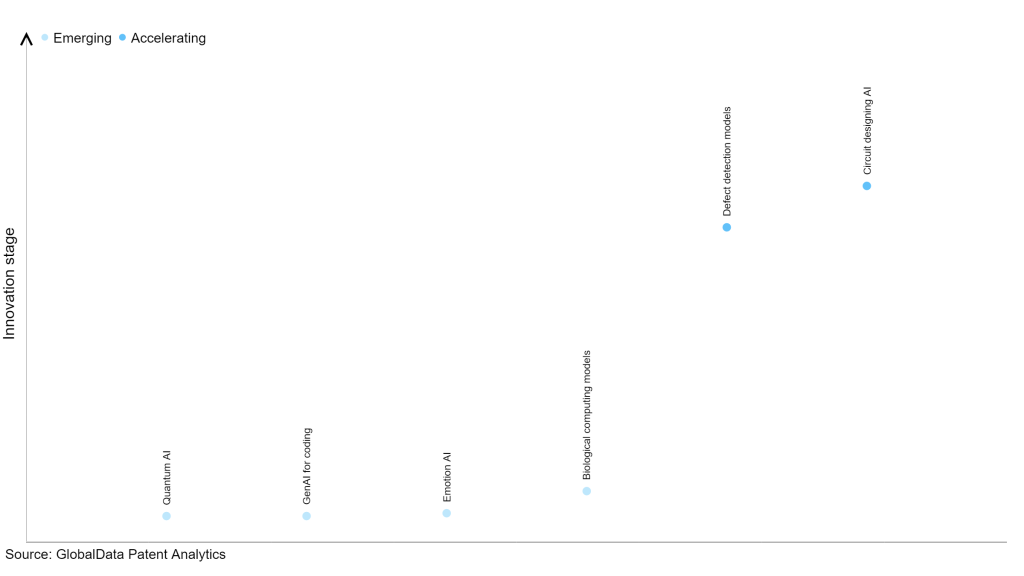The technology industry continues to be a hotbed of patent innovation. Activity is driven by the increasing demand for precision and efficiency in defect detection, which is particularly critical in industries like electronics, automotive, and pharmaceuticals, and growing importance of technologies such as convolutional neural networks (CNNs), anomaly detection algorithms, and natural language processing (NLP). In the last three years alone, there have been over 1.5 million patents filed and granted in the technology industry, according to GlobalData’s report on Artificial intelligence in technology: defect detection models. Buy the report here.
However, not all innovations are equal and nor do they follow a constant upward trend. Instead, their evolution takes the form of an S-shaped curve that reflects their typical lifecycle from early emergence to accelerating adoption, before finally stabilizing and reaching maturity.
Identifying where a particular innovation is on this journey, especially those that are in the emerging and accelerating stages, is essential for understanding their current level of adoption and the likely future trajectory and impact they will have.
185+ innovations will shape the technology industry
According to GlobalData’s Technology Foresights, which plots the S-curve for the technology industry using innovation intensity models built on over 1.6 million patents, there are 185+ innovation areas that will shape the future of the industry.
Within the emerging innovation stage, quantum AI, GenAI for coding and emotion AI are disruptive technologies that are in the early stages of application and should be tracked closely. Biological computing models, defect detection models, and circuit designing AI are some of the accelerating innovation areas, where adoption has been steadily increasing.
Innovation S-curve for artificial intelligence in the technology industry

Defect detection models is a key innovation area in artificial intelligence
Defect detection models are techniques and systems that employ image processing and pattern recognition methods to recognize and categorize defects or anomalies in different objects or goods. They utilize algorithms for pattern matching, shape recognition, and image analysis to compare captured object images with predetermined models or templates, ensuring precise identification of defects or deviations from the expected standard.
GlobalData’s analysis also uncovers the companies at the forefront of each innovation area and assesses the potential reach and impact of their patenting activity across different applications and geographies. According to GlobalData, there are 535+ companies, spanning technology vendors, established technology companies, and up-and-coming start-ups engaged in the development and application of defect detection models.
Key players in defect detection models – a disruptive innovation in the technology industry
‘Application diversity’ measures the number of applications identified for each patent. It broadly splits companies into either ‘niche’ or ‘diversified’ innovators.
‘Geographic reach’ refers to the number of countries each patent is registered in. It reflects the breadth of geographic application intended, ranging from ‘global’ to ‘local’.
Patent volumes related to defect detection models
Source: GlobalData Patent Analytics
Among the companies innovating in AI in defect detection models, KLA is one of the leading patents filers. The company’s patents are aimed at developing system, technique, and non-transient computer-readable storage medium for training and utilizing defect classifiers in wafers with deeply layered structures. The process involves obtaining several images captured by an inspection system at a defect location on the wafer, with each image being taken using a distinct focus setting due to the multiple stacked layers. Subsequently, the defect is classified based on the information derived from these images. The other prominent patent filers in the space include Applied Materials and Omni MedSci.
In terms of application diversity, KLA leads the pack, while Nanotronics Imaging and Omni MedSci stood in the second and third positions, respectively. By means of geographical reach, MiTAC-Synnex held the top position, followed by Sight Diagnostics and Nanotronics Imaging.
AI in defect detection models can drastically improve the accuracy, speed, and efficiency of identifying flaws or irregularities in products or processes. By leveraging advanced algorithms and pattern recognition techniques, AI-powered defect detection models can discern subtle defects that may be difficult for human inspectors to detect. This leads to higher quality assurance and significantly reduces the likelihood of faulty products reaching consumers.
To further understand the key themes and technologies disrupting the technology industry, access GlobalData’s latest thematic research report on Artificial Intelligence (AI).
Data Insights
From

The gold standard of business intelligence.
Blending expert knowledge with cutting-edge technology, GlobalData’s unrivalled proprietary data will enable you to decode what’s happening in your market. You can make better informed decisions and gain a future-proof advantage over your competitors.







